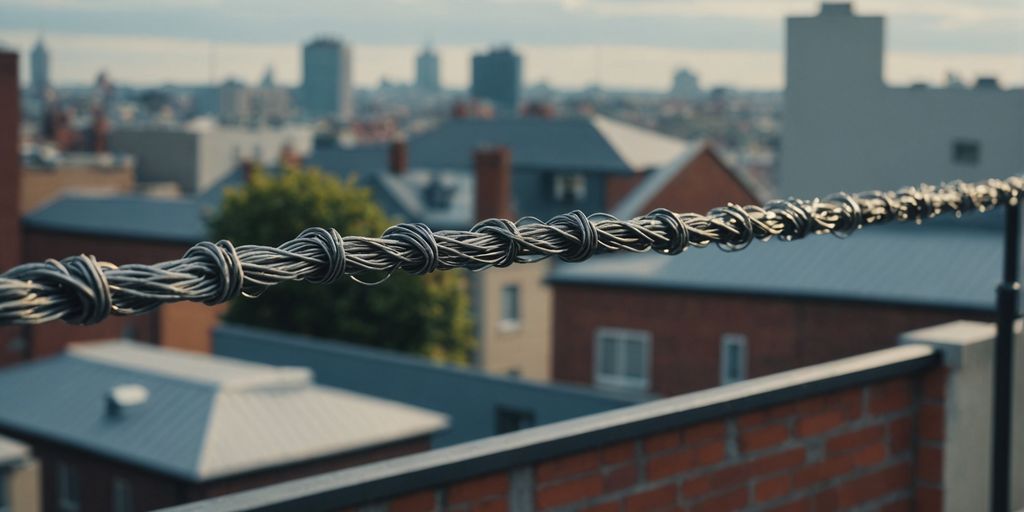Anti Bird Wire is an effective and humane solution for deterring birds from landing and nesting on various surfaces. It is widely used in both residential and commercial settings to protect properties from the damage and mess caused by birds. This article explores the different types of anti bird wire systems, their benefits, installation procedures, and how they compare to other bird deterrent methods.
Key Takeaways
- Anti Bird Wire is a humane and effective method to deter birds from landing and nesting on surfaces.
- There are various types of anti bird wire systems, including spring-tensioned, nylon-coated, and stainless steel post systems.
- Proper installation is crucial for the effectiveness of anti bird wire systems, and common mistakes should be avoided.
- Anti Bird Wire systems are suitable for residential, commercial, and industrial applications.
- Regular maintenance, including inspections and cleaning, is essential to ensure the longevity and effectiveness of anti bird wire systems.
Understanding Anti Bird Wire
What is Anti Bird Wire?
Anti Bird Wire is a discreet and effective bird control solution designed to deter large birds such as pigeons, seagulls, and crows from landing or roosting on various surfaces. This bird deterrent kit typically consists of stainless steel posts and spring-tensioned wires, creating an unstable landing area that discourages birds from settling. The system is widely used due to its low visual impact and versatility, making it suitable for ledges, parapet walls, windowsills, signs, beams, and other flat surfaces.
How Does Anti Bird Wire Work?
The Anti Bird Wire system works by creating an uneven and unstable surface that birds find difficult to land on. The spring-tensioned wires are attached to posts at different heights, making it challenging for birds to perch. When birds attempt to land on the wire, the instability causes them to move on to a more stable area. This method is humane and does not harm the birds, simply encouraging them to find alternative roosting spots.
Benefits of Using Anti Bird Wire
- Discreet Appearance: The system is nearly invisible from a distance, maintaining the aesthetic appeal of buildings and structures.
- Versatile Application: Can be installed on various surfaces, including ledges, beams, signs, and more.
- Durable Materials: Made from stainless steel, the system is long-lasting and resistant to weather conditions.
- Humane Solution: Does not harm birds, simply deters them from landing or roosting.
- Cost-Effective: Provides a low-cost solution for bird control compared to other methods.
By using Anti Bird Wire, property owners can effectively stop birds nesting under solar panels and other critical areas, ensuring the longevity and efficiency of their installations.
In summary, Anti Bird Wire is a practical and humane bird deterrent that offers numerous benefits for both residential and commercial applications. Its discreet design and effectiveness make it a popular choice for those looking to protect their properties from bird-related damage.
Types of Anti Bird Wire Systems
Anti bird wire systems are essential for deterring birds from perching or nesting on various structures. These systems are designed to be both effective and discreet, ensuring minimal visual impact while providing robust bird control. Below are the primary types of anti bird wire systems available:
Spring-Tensioned Systems
Spring-tensioned systems use stainless steel wires attached to posts, creating an unstable landing area for birds. This method is highly effective for deterring larger birds like pigeons and seagulls. The wires are kept taut by springs, ensuring they remain effective over time. These systems are commonly used on ledges, parapet walls, and other flat surfaces.
Nylon-Coated Wire Systems
Nylon-coated wire systems offer a more flexible and less visible option for bird deterrence. The nylon coating provides additional durability and weather resistance, making it suitable for various environments. These systems are often used in areas where aesthetics are a concern, as the nylon coating can blend in with the surroundings.
Stainless Steel Post Systems
Stainless steel post systems are known for their durability and strength. These systems use stainless steel posts and wires to create a robust barrier against birds. They are ideal for high-traffic areas and locations exposed to harsh weather conditions. The stainless steel components ensure a long-lasting solution with minimal maintenance requirements.
When choosing an anti bird wire system, consider the specific needs of your location and the types of birds you aim to deter. Each system offers unique benefits and can be tailored to fit various applications, from residential to industrial settings.
Installation of Anti Bird Wire
Tools and Materials Needed
To install an anti bird wire system, you’ll need a variety of tools and materials. These include:
- Stainless steel posts
- Stainless steel wires
- Springs for tensioning
- Anchor rivets or adhesive bases
- Drill and drill bits
- Measuring tape
- Safety gear (gloves, goggles)
Step-by-Step Installation Guide
- Measure the area where the anti bird wire will be installed.
- Drill holes for the posts or use adhesive bases to secure them in place.
- Attach the stainless steel posts to the drilled holes or adhesive bases.
- Thread the stainless steel wire through the posts, ensuring it is taut by using the springs for tensioning.
- Secure the wire at both ends, making sure it is properly tensioned to create an unstable landing area for birds.
- Inspect the installation to ensure all components are securely fastened and the wire is properly tensioned.
Proper installation is crucial for the effectiveness of the anti bird wire system. Incorrect tensioning or positioning can render the system ineffective.
Common Installation Mistakes
- Incorrect tensioning of the wire, which can make the system ineffective.
- Using inappropriate materials that may not withstand weather conditions.
- Failing to measure the area accurately, leading to insufficient coverage.
- Not securing the posts properly, which can cause the system to fail.
By following these steps and avoiding common mistakes, you can ensure a successful installation of your anti bird wire system. This method is not only effective but also a discreet alternative to more visible deterrents like Pigeon Spikes For Solar Panels.
Applications of Anti Bird Wire
Residential Use
Anti bird wire is an effective solution for homeowners looking to protect their property from bird-related damage. It is particularly useful for keeping birds away from ledges, windowsills, and rooftops. This system is discreet and does not compromise the aesthetic appeal of the home. Additionally, it is a humane method that prevents birds from perching without causing them harm.
Commercial Use
Businesses can benefit greatly from the installation of anti bird wire. It is commonly used on commercial buildings to prevent birds from roosting on signs, beams, and other flat surfaces. This not only helps in maintaining the cleanliness of the property but also protects the structural integrity of the building. The pigeon guard for solar panels offers eco-friendly solutions for protecting solar panels with mesh barriers and clips, ensuring longevity and efficiency.
Industrial Use
In industrial settings, anti bird wire is essential for safeguarding machinery and equipment from bird droppings and nesting materials. Various deterrent methods available for comprehensive defense. This system is particularly beneficial in warehouses, factories, and other large facilities where bird infestations can lead to significant operational disruptions. The use of anti bird wire in these environments ensures a safer and more hygienic workspace for employees.
Anti bird wire systems are versatile and can be adapted to various environments, making them a valuable investment for both residential and commercial properties.
Comparing Anti Bird Wire with Other Bird Deterrents
When it comes to bird deterrents, there are several options available, each with its own set of advantages and disadvantages. Anti bird wire is one of the most effective and unobtrusive solutions, but how does it compare to other methods? Let’s explore the differences between anti bird wire, bird netting, bird spikes, and visual bird deterrents.
Bird Netting
Bird netting is a popular choice for large areas that need protection from birds. It creates a physical barrier that prevents birds from accessing certain areas. However, it can be more visually intrusive compared to anti bird wire and may require more maintenance to ensure it remains effective. Bird netting is often used in agricultural settings and large commercial spaces.
Bird Spikes
Bird spikes are another common bird deterrent. They are easy to install and can be effective in preventing birds from landing on ledges and other surfaces. However, bird spikes can be more noticeable and may not be as eco-friendly as anti bird wire. Additionally, they can sometimes harm birds if not installed correctly.
Visual Bird Deterrents
Visual bird deterrents, such as fake predators or reflective objects, are designed to scare birds away. These methods can be effective in the short term but often lose their effectiveness as birds become accustomed to them. Visual deterrents are usually less reliable than physical barriers like anti bird wire or bird netting.
For those looking to protect their solar panels, combining anti bird wire with other methods like bird netting or spikes can offer comprehensive protection. This is especially important for those wondering How To Keep Pigeons Away From Solar Panels and ensure the longevity of their investment.
In summary, while each bird deterrent method has its own benefits, anti bird wire stands out for its unobtrusive design and effectiveness. It is particularly useful for those seeking a Solar Panel Critter Guard solution that is both humane and efficient.
Maintenance of Anti Bird Wire Systems
Regular Inspections
Regular inspections are crucial to ensure the effectiveness of your anti bird wire system. Weather resistance is a key factor to consider during these inspections. Check for any signs of wear and tear, especially after severe weather conditions. Ensure that the wires are still taut and the posts are firmly in place. If you notice any slack or damage, it may be time for some adjustments or replacements.
Cleaning Tips
Keeping your anti bird wire system clean is essential for its longevity and effectiveness. Dirt and debris can accumulate on the wires and posts, reducing their effectiveness. Use a soft brush or cloth to gently clean the wires and posts. Avoid using harsh chemicals that could damage the materials. For areas with high bird activity, more frequent cleaning may be necessary to maintain optimal performance.
Repair and Replacement
Over time, parts of your anti bird wire system may need to be repaired or replaced. Regular maintenance can help identify issues early, but sometimes repairs are unavoidable. When replacing parts, ensure you use high-quality materials to maintain the system’s effectiveness. For example, if you have a Pigeon Guard For Solar Panels, make sure the replacement parts are compatible with your existing setup. Proper maintenance and timely repairs can extend the life of your anti bird wire system, providing long-term protection for solar panels and other structures.
Regular maintenance not only ensures the effectiveness of your anti bird wire system but also extends its lifespan, making it a cost-effective solution for bird control.
Legal Considerations for Bird Deterrents
Wildlife Protection Laws
When implementing bird deterrent systems, it’s crucial to be aware of wildlife protection laws. The Wildlife and Countryside Act 1981 and the Wildlife (Northern Ireland) Order 1986 protect all bird species. This means that any deliberate harm to birds, their nests, or eggs is illegal. In Scotland and Northern Ireland, it is also unlawful to prevent birds from accessing their nests or to disturb nesting birds.
Permits and Regulations
Before installing any bird deterrent system, check if you need specific permits or if there are regulations you must follow. These can vary depending on your location and the type of deterrent you plan to use. For example, some areas may require permits for installing bird netting or spikes.
Ethical Considerations
While bird deterrents are essential for protecting property, it’s important to choose humane methods. Systems like spring-tensioned wire are effective yet do not harm birds. Always opt for solutions that prevent birds from roosting without causing them injury.
Ensuring that your bird deterrent methods comply with legal and ethical standards not only protects wildlife but also helps you avoid potential legal issues.
Cost of Anti Bird Wire Systems
When considering the installation of anti bird wire systems, it’s essential to understand the various costs involved. These systems can be a cost-effective solution for protecting your property from bird damage, but the initial investment and long-term savings should be carefully evaluated.
Initial Investment
The initial cost of anti bird wire systems can vary depending on the type and length of the wire, as well as the complexity of the installation. For example, a 4-meter kit of anti bird wire deterrent can cost around $79.90, while a 100-meter kit is priced at approximately $179.90. Additional components such as spring grips, anchor rivets, and crimping tools can add to the overall cost. It’s important to budget for these additional materials to ensure a successful installation.
| Item | Price |
|---|---|
| Anti Bird Wire Deterrent – 4m Kit | $79.90 |
| Anti Bird Wire Deterrent – 100m | $179.90 |
| Spring Grips | $13.90 |
| Anchor Rivets (100pk) | $41.90 |
| Crimper & Cutter Tool | $99.00 |
| Crimps Nickel Plated (100pk) | $23.90 |
| Stainless Steel Post (100pk) | $129.90 |
Long-Term Savings
Investing in anti bird wire systems can lead to significant long-term savings by preventing damage to your property. Bird droppings and nesting materials can cause extensive damage to buildings, machinery, and solar panels. By installing anti bird wire, you can avoid costly repairs and maintenance. For instance, the Critter Guard Solar Cost can be mitigated by using bird wire to protect solar panels from bird-related damage.
Cost Comparison with Other Methods
When comparing the cost of anti bird wire systems to other bird deterrent methods, such as bird netting or bird spikes, it’s clear that each method has its own advantages and price points. Bird spikes, for example, may have a lower initial cost but might not be as effective in certain situations. The Bird Spike Installation Cost can vary, but it’s crucial to consider the effectiveness and longevity of each method.
Investing in anti bird wire systems is a strategic decision that can protect your property and save you money in the long run. By understanding the initial investment and potential savings, you can make an informed choice that best suits your needs.
Customer Reviews and Testimonials

Success Stories
Many customers have shared their positive experiences with anti bird wire systems. One customer from San Fernando, CA mentioned how the installation of anti bird wire significantly reduced bird-related issues around their solar panels. They highlighted the ease of installation and the immediate impact on bird deterrence.
Common Complaints
While most feedback is positive, some users have noted a few drawbacks. A common complaint is the need for regular maintenance to ensure the wire remains effective. Additionally, some users found the initial setup to be slightly challenging without professional help.
Expert Opinions
Experts in the field of bird control emphasize the importance of choosing the right type of anti bird wire system for specific needs. They recommend consulting with professionals to ensure optimal results and to avoid common pitfalls during installation.
"The right anti bird wire system can make a significant difference in protecting your property from bird damage," says a leading expert in bird control solutions.
Innovations in Bird Deterrent Technology
Smart Bird Deterrents
The advent of smart technology has revolutionized bird deterrent systems. Smart bird deterrents utilize sensors and automated responses to keep birds away from specific areas. These systems can detect bird presence and activate deterrents like sound, light, or water sprays. This technology is particularly useful for protecting sensitive installations such as solar panels.
Eco-Friendly Solutions
Eco-friendly bird deterrents are gaining popularity as they offer a humane way to manage bird populations. These solutions often involve the use of natural bird deterrents like predator decoys or organic repellents. They are designed to be safe for both birds and the environment, making them an ethical choice for bird control.
Future Trends
The future of bird deterrent technology looks promising with continuous advancements. Innovations such as bird deterrent speakers that emit specific frequencies to deter birds and more efficient pigeon removal services are on the horizon. Additionally, there is ongoing research into how to stop pigeons nesting in urban areas without causing harm to the birds. These trends indicate a move towards more sophisticated and humane bird control methods.
As technology evolves, the focus is shifting towards creating bird deterrent systems that are not only effective but also environmentally friendly and humane.
DIY vs Professional Installation
Pros and Cons of DIY
Opting for a DIY installation of anti bird wire can be a cost-effective solution. However, it requires a certain level of skill and knowledge to ensure the installation is effective and safe. Here are some pros and cons to consider:
Pros:
- Cost savings on labor
- Flexibility to work on your own schedule
- Personal satisfaction from completing the project
Cons:
- Potential for improper installation
- Lack of professional tools and materials
- Time-consuming and physically demanding
When to Hire a Professional
Hiring a professional for your anti bird wire installation can be a wise decision, especially for larger or more complex projects. Professionals have the expertise and equipment to ensure a high-quality installation. Consider hiring a professional if:
- The installation area is difficult to access
- You lack the necessary tools and materials
- You want to ensure compliance with local regulations
Cost Implications
While DIY installation may save you money upfront, hiring a professional can offer long-term savings by preventing potential issues and ensuring the job is done right the first time. Here’s a quick comparison:
| Aspect | DIY Installation | Professional Installation |
|---|---|---|
| Initial Cost | Low | High |
| Time Investment | High | Low |
| Quality Assurance | Variable | High |
| Long-term Maintenance | Potentially High | Low |
Investing in a professional installation can be a critter guard for solar panels – essential investment for clean energy protection.
For those considering a DIY approach, companies like Goldshot Exterminating offer resources and tools to help you get started. However, for peace of mind and optimal results, professional installation is often the best route.
Choosing between DIY and professional installation for your solar panels can be challenging. While DIY might save you some money upfront, professional installation ensures optimal performance and long-term benefits. Visit our website to learn more about our comprehensive solar services and find the best solution for your needs.
Conclusion
In conclusion, anti bird wire systems offer a highly effective and humane solution for deterring pest birds from landing and roosting on various surfaces. By creating an unstable landing area, these systems prevent birds from settling, thereby protecting properties from the damage and health risks associated with bird droppings and nesting materials. While there are several methods available for bird-proofing, including netting, spikes, and chemical repellents, anti bird wire stands out due to its low visual impact and long-lasting durability. Whether used on historic buildings, modern structures, or solar panels, anti bird wire provides a versatile and reliable option for maintaining a bird-free environment. Investing in such a system not only safeguards your property but also ensures compliance with wildlife protection laws, making it a responsible and practical choice for bird control.
Frequently Asked Questions
What is Anti Bird Wire?
Anti Bird Wire is a bird control solution that uses a series of tensioned wires to create an unstable landing surface, preventing birds from perching on treated areas.
How does Anti Bird Wire work?
Anti Bird Wire works by suspending thin, tensioned wires between posts. When birds attempt to land on these wires, the instability discourages them from staying.
What are the benefits of using Anti Bird Wire?
The benefits include being a humane and discreet bird control method, effective in preventing large birds like pigeons and seagulls from perching, and having minimal visual impact on buildings.
Can Anti Bird Wire be used on historic buildings?
Yes, Anti Bird Wire is approved for use on historic buildings due to its low-profile and minimal visual impact.
What types of surfaces can Anti Bird Wire be installed on?
Anti Bird Wire can be installed on various surfaces including ledges, parapet walls, windowsills, beams, and signs.
Is Anti Bird Wire a humane bird control method?
Yes, Anti Bird Wire is a humane method as it does not harm the birds but simply discourages them from landing on treated surfaces.
What materials are used in Anti Bird Wire systems?
Anti Bird Wire systems typically use stainless steel posts and nylon-coated stainless steel wires to ensure durability and effectiveness.
Are there any legal considerations when installing Anti Bird Wire?
Yes, it is important to comply with local wildlife protection laws and regulations, as well as ethical considerations when installing any bird deterrent system.



